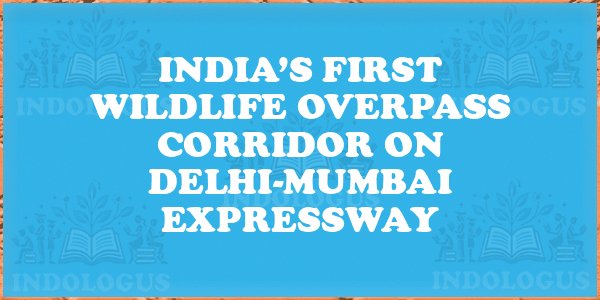The National Highways Authority of India (NHAI) has unveiled India’s longest wildlife overpass corridor on a 12-kilometre stretch of the Delhi-Mumbai Expressway. This initiative aims to promote wildlife conservation while ensuring safe animal movement across the Ranthambore Tiger Reserve’s buffer zone.
Key Features
- Length of Segment: 12 km of Delhi-Mumbai Expressway through the Ranthambore buffer zone
Structures Built
- 5 overpasses (each 500 metres long)
- 1 underpass (1.2 km, India’s longest for wildlife)
- 5 km of elevated/sunken expressway to match terrain
- 4-metre-high wall and 2-metre sound barriers for protection
Environmental Measures
- Natural Contour Design: Overpasses follow original terrain to ensure minimal disruption
- Manpower Deployment: Every 200 metres during construction to prevent harm to wildlife
- Post-Construction Monitoring: Camera evidence confirms tiger and bear movement through corridors
Eco-Friendly Additions
- Plantation of 35,000 trees
- Installation of rainwater harvesting systems
- Modular construction to reduce waste
Objectives & Aim
- Ensure safe passage for wildlife between Ranthambore and Chambal Valley
- Minimize roadkill and reduce human-animal conflict
- Demonstrate how green infrastructure can coexist with development
Broader Context
- Punjab is planning its first urban wildlife corridor via the Zirakpur bypass project
- Maharashtra’s Samruddhi Mahamarg includes 209 animal/pedestrian underpasses and 8 wildlife over/underpasses
- These developments highlight a national shift towards wildlife-inclusive infrastructure
Summary/Static Details
- Why in the news? 12-km stretch for Wildlife, Delhi-Mumbai Expressway (Ranthambore buffer zone)
- Wildlife Structures: 5 overpasses, 1.2-km underpass (India’s longest), walls & barriers
- Purpose: Safe movement of wildlife (tigers, bears, leopards)
- Environmental Measures: Tree plantation, rainwater harvesting, terrain-sensitive design
- Agencies Involved: NHAI, Wildlife Institute of India, Ministry of Environment
- Related Projects: Zirakpur Urban Corridor (Punjab), Samruddhi Mahamarg (Maharashtra)
Key Takeaways for Competitive Exams
- India’s first wildlife overpass corridor on Delhi-Mumbai Expressway promotes eco-sensitive infrastructure.
- The project aims to reduce human-animal conflicts near protected zones.
- Environmental measures include tree plantation, rainwater harvesting, and wildlife-friendly design.
- Similar initiatives in Punjab and Maharashtra indicate a national trend towards wildlife-inclusive infrastructure.



